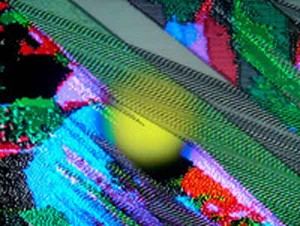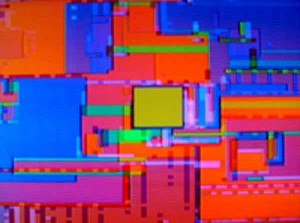Photosonicneurokinaesthography means ‘to write the movement of neurons through the use of sound and light’, a practice that blurs the boundaries between science, art and philosophy to the point where they become meaningless. Originally developed in a primitive form by Dr Arkady Botborger. The principles behind Photosonicneurokinaesthography are, in Dr Botborger’s own words, “quite elementary, once one joins the dots between them”. Put simply, these theories state that sound, light and three-dimensional space are in fact one and the same phenomena, which the human perceptual apparatus is “woefully unequipped to perceive as a totality”. This fundamental phenomenon is, according to Dr Botborger’s theories, vibration. Botborger wrote, “we accept that sound is a result of the interactions of vibrations through the air with the specialized technology of the ear, which has evolved to perceive these vibrations, and that solid objects appear solid because the atoms which comprise them are held together by vibrational fields, although these individual atoms are comprised almost entirely of ‘empty’ space between their components. Once again, we have evolved a specialized technology to enable us to perceive this, and yet another to allow us to locate these so called ‘solid’ objects in space. These are accepted ‘truths’ that most will not try to argue against. Although we are taught that there are five senses all of which function through the central nervous system, few realise this is actually a sole perceptual technology we possess. From here it is a small step to conclude we are in fact receiving only one sensory stream through an incomplete, or perhaps more accurately, fragmented perceptual system, but I suppose most are not taught to think for themselves”. [1]
These theories were developed initially in Scandinavia in the mid 1930′s, after Botborger’s meeting and subsequent correspondence with Wilhelm Reich following the latter’s escape from Nazi Germany in 1934. Reich wrote to an American contemporary in 1941 “Arkady Botborger is a quite remarkable young man. One day, his ideas will be properly understood, but this day is long off, and a civilisation which can accept and integrate these ideas will be unrecognisable to most of us today”.[2] Botborger’s initial research projects in the early 1950′s were conducted in secret under the auspices of the KGB. It was hoped at the time that new techniques and technologies for interrogation would emerge from this research, in a similar fashion to what the CIA was seeking from its MK-Ultra program experiments with LSD. After an initial flurry of interest, the researches were discontinued due to a lack of ‘relevant results’. Subjects of the experiments reported feelings of calm and wellbeing, increased awareness of colour and sound and strong synaesthetic effects. In many cases subjects described these effects in terms of a spiritual or religious experience. These effects, particularly the synaesthesia between sound and colour, were noted as lasting for long periods of time after their exposure to the process, and in some cases, permanently. These results fascinated Botborger, who began to believe that through repeated applications of the device, subjects would begin to evolve newer, more complete sensory structures, which may be able to be passed on through subsequent generations.
Although it would appear primitive when compared to the compact technologies of today, the original Photosonicneurokinaesthetograph constructed by Dr Botborger, was a technical marvel of its day and a masterpiece of ingenuity. Constructed largely from a complex system of voltage controlled oscillators, tape machines, oscilloscopes, light sensitive diodes, lenses, mirrors, speakers and prisms, and designed for one operator and one ‘patient’, this device took up the bulk of an entire room – far too big to ever be demonstrated publicly. Undeterred, Botborger presented his findings at several scientific conferences in the early and mid 1950′s, mostly those focused on psychotherapy. He was met universally with howls of derision and denounced as a charlatan, often, ironically, by those still advocating such theories as phrenology. [3]
Following the discontinuation of the funding for his research in what is believed to be 1957, Botborger received permission to leave the USSR to move to Norway. Having observed not only the ill treatment of his close friend Reich by the United States government and also what he considered to be the complete misunderstanding of Reich’s work by even the most ‘advanced’ in the scientific community, Botborger all but retired from the world, maintaining only a few correspondences. Although he continued to advance his theories in private, with no funds available to enable him to reconstruct a photosonicneurokinaesthograph, these advances remained pure thought experiments. In 1973, he emerged briefly from his self-imposed exile to attend a conference in San Francisco on the subject of “Occult Technologies and Alternative Science”. Despite being one of the keynote speakers for this conference, Botborger did not end up delivering his paper, instead berating the audience for their “pathetic credulity” and “obsessing over morons like Crowley or Leary, seeking ‘newer’ and ‘better’ ways to express the basest, most animal impulses and forever searching for the intellectual alpha male to whom they can endlessly subjugate themselves, reaching unquestioningly and aimlessly for the shiny rocks at their feet they are promised the stars”[4].
From here, the history of Photosonicneurokinaesthography becomes obscure, with no references found until its first live demonstrations by Botborg in Australia, late 2004. The members of Botborg choose to remain anonymous and would not consent to be interviewed for this article, but did issue the following statement; “We met Dr Botborger in northern Norway in the winter of 1979 (roughly 2 years before his death), while undertaking intensive experiments in sensory deprivation. He remains the most highly evolved human being we have met on our travels. We discussed his ideas with him at great length, and resolved to investigate their practical applications further when technology permitted. This research began, ironically enough, shortly after the turn of the farcical millennium. We have chosen to present this research as ‘art’ rather than ‘science’ as we have more opportunities to give demonstrations in this field, and additionally, we are able to bypass the primitive, territorial, reptilian parts of the brain, which remain dominant in the thinking of the scientific community. The advances in technology since Dr Botborger first constructed his Photosonicneurokinaesthetograph enable us to set up our device almost anywhere, and to travel easily with all the required components. It is possible, in fact, for a functional, if basic Photosonicneurokinaesthetograph to be constructed from relatively common ‘prosumer’ technologies, but the benefits that are derived from the presence of a skilled operator cannot be overstated. We are currently the sole public demonstrators of the practical applications of Dr Botborger’s theories although there are also those who offer private therapeutic courses. We maintain little contact with these practitioners, preferring to present our work as publicly and freely as possible.”
[1] “1st International Conference of Occult Technologies and Alternative Sciences – Collected Papers and Abstracts”; Phoenix Free Press; San Francisco, 1972.
[2] “The Surviving Letters of Wilhelm Reich”; Radical Minds Publishing, Paris, 1984
[3] “1st International Conference of Occult Technologies and Alternative Sciences – Collected Papers and Abstracts”; Phoenix Free Press; San Francisco, 1972.
[4] Phrenology is a theory which claims to be able to determine character, personality traits and criminality on the basis of the shape of the head (i.e. by reading bumps and fissures) http://en.wikipedia.org/wiki/Phrenology
Read More
 This work is licensed under a Creative Commons Attribution-NonCommercial-ShareAlike 2.5 Australia.
This work is licensed under a Creative Commons Attribution-NonCommercial-ShareAlike 2.5 Australia.









